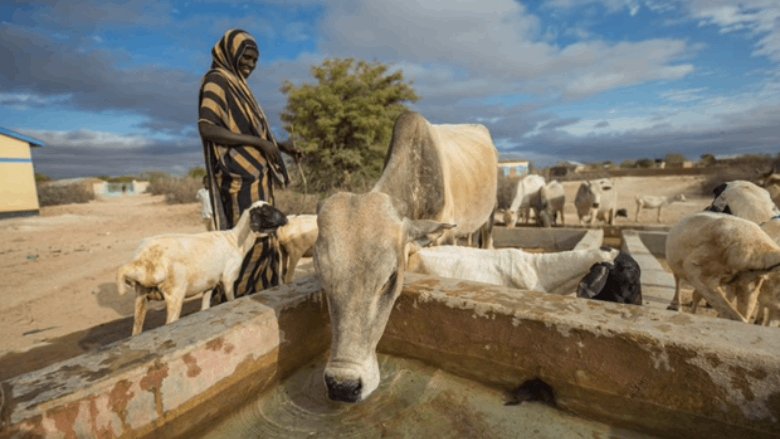Dryland dominates the landmass of Djibouti, Ethiopia, Eritrea, Kenya, Somalia, South Sudan, Sudan and Uganda – countries in the Horn of Africa that make up the Intergovernmental Authority on Development (IGAD) region. For millennia, pastoralism has adapted to the dryland and dominated the region’s livestock production. Meat and other livestock products provide the main source of protein in the human diet. Seasonal transhumance – the practice of moving livestock from one grazing ground to another – in search of water, pasture and minimally informal trade involves crossing international borders in the region. Hence, livestock production requires regional cooperation and coordination.
The Horn of Africa region is highly affected by climate variability, particularly the drylands. Rainy and dry seasons are becoming less predictable, leading to both longer and more severe droughts and floods. Due to droughts and floods between 2021 to 2022, several countries in the region lost a total of 10.1 million heads of livestock worth $1 billion. These phenomena are diminishing productivity, also exacerbating food insecurity which is forcing millions into famine.
Droughts have had a regional impact, and climate projections show consistent trends of increased drought frequency and intensity across the region, which calls for regional collaboration and solutions. On the other hand, livestock is also a significant emitter of greenhouse gases in this region due to large number of ruminants. Most emissions derive from grazing animals emitting methane as part of their digestive process.
A regional strategy for climate resilient livestock production and economic growth
To address these challenges, IGAD’s Centre for Pastoral Areas and Livestock Development (ICPALD) and the World Bank Program for Climate Smart Livestock Systems in Africa supported IGAD member states to develop a “Strategy for Sustainable and Resilient Livestock Development in view of Climate Change 2022-2037.” Support for developing the Strategy was provided by Germany’s Federal Ministry of Economic Cooperation and Development (BMZ) through the German Agency for International Cooperation (GIZ).
The Strategy aims to increase the resilience and sustainability of the livestock sector to climate change impact in the region. It envisions a more resilient, productive, and sustainable livestock sector in the region for improved living standards and reduced vulnerability to climate change.
The Strategy includes five priority intervention areas:
- Mechanisms for climate risk management: financial instruments for climate risk management, early warning and response, and risk profiling and contingency planning.
- Natural resource base and ecosystem services for livestock production: actions that target rangeland and woodland management, water availability and access, and biodiversity and the control of invasive species.
- Livestock production and income diversification along livestock value chains: practices that make the sector more resilient, by improving productivity and diversifying income sources within and outside of livestock production.
- Research, innovation, and knowledge management: regional cooperation and the development of future innovations for longer-term adaptation.
- Policy alignment, coherence, and coordination for transboundary issues: streamline and improve the alignment of policy action throughout IGAD intraregional boundaries.
“Transhumance [the practice of moving livestock from one grazing ground to another in a seasonal cycle – editor’s note] is an essential and time-tested adaptation by the pastoralists to dryland environment because availability of water and forage varies in space and time,” said Dereje Wakjira, ICPALD Director.
Since seasonal transhumance for better access to feed and water resources span across the borders of IGAD member states, regional collaboration is crucial. A 2020 IGAD Protocol on Transhumance already provides legislative framework, but the new strategy further strengthens governance and cross-border coordination mechanisms.
The strategy incorporates practices developed by livestock herders over hundreds of years to cope with climate change variability. This includes destocking by selling male animals that are unproductive before a drought to have a smaller herd to maintain.
“In the areas that are most affected by climate change, the people that are moving with livestock face the biggest challenges, as the rangelands and their typical migration routes are disrupted,” Clark Halpern, World Bank Climate Smart Agriculture Analyst, added.
The strategy includes financial and technical mechanisms for pastoralists, aimed at preparing and responding to climate shocks. Instruments such as catastrophe bonds or insurance pools have a bigger impact when established at the regional scale. Other instruments like livestock insurance, which pays out benefits for losses related to weather and catastrophic events, have been successfully piloted and could benefit other countries with regional collaboration and sharing of experience.
"Acknowledging traditional coping and adaptation mechanisms, the strategy provides a framework to support their implementation that draws on latest technology and policy instruments, and also proposes novel forms of interventions and tools to build resilience,” explains Pierre Gerber, World Bank Senior Agriculture Economist.
Rangeland restoration (essentially the process of regenerating the grassland cover and the organic matter in soils) is key in both climate change adaptation and mitigation. The strategy describes interventions to improve feed availability during the dry season and ensure adaptive levels of grazing pressure, that can reverse degradation trends and achieve restoration. Implementing such practices requires real-time agro-ecological data. Regional cooperation for data sharing, research and innovation can lower the costs and make such interventions viable in the shorter term.
By having the first comprehensive regional livestock strategy, countries in the Horn of Africa region are better placed to implement policies and investment with the goal of resilient communities and food systems.

